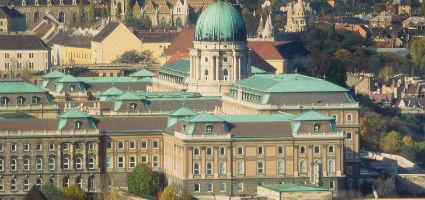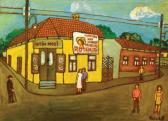2025. July 19. Saturday
Budapest History Museum - Budapest
 |
Address: 1014, Budapest Szent György tér 2.
Phone number: (1) 487-8800, (1) 487-8801
E-mail: btm@mail.btm.hu
Opening hours: Tue-Sun 10-18
|
The exhibition has closed for visitors.
2010.06.02. - 2010.07.18.
Museum tickets, service costs:
|
Ticket for adults
|
2000 HUF
|
|
|
Ticket for students
|
1000 HUF
|
|
|
Group ticket for students
(over 10 people)
|
500 HUF
|
|
|
Ticket for pensioners
|
1000 HUF
|
|
|
Ticket for families
|
2200 HUF
|
/ family
|
|
Group guide
(up to 20 people)
|
7000 HUF
|
|
|
Group guide
(20-30 people)
|
9500 HUF
|
|
|
Group guide
|
14000 HUF
|
|
|
Group guide
|
18000 HUF
|
|
|
Audio guide
|
1200 HUF
|
|
|
Photography
|
1000 HUF
|
Richárd Kadarkuti was born in Pesterzsébet. His father was a bricklayer, his mother a factory worker. As his father died at a young age and his mother had to work, he and his sibling were raised by his grandmother. Richárd Kadarkuti's uncle, Pepi, was a turner who introduced him to painting. It was him from whom he first got pencils, crayons and books on painting, too.

After elementary school Richárd Kadarkuti worked in Csepel until 1949. However, he joined the art group in the factory where he developed his artistic skills, but not for long, as those time activities like that were not accepted by the factory leaders. He graduated from the School of Economy in Kecskemét, and then he continued his studies at the Economics University in Budapest. He first began working at the Hungarian Plan Office. Then he changed jobs and began working at the Csepel Machine Factory where he stayed until his retirement.
Richárd Kadarkuti loved drawing and painting in childhood, but only turned to painting consciously relatively late. His topics were directly related to nature. He painted people living around him, his grandmother, family members, friends and the county he lived at. He painted streets, yards, interiors, trams, movie theatres. Among Naive artists, Karadkuti is considered an 'urban' painter. He often painted topics more than once, mostly recollecting his experiences.
Richárd Kadarkuti, his wife and daughter lived at 16 Kinizsi Street, in a block of flats, for long. That was the place where he created the first colour compositions closed with black contours. These paintings preserve images and dreams of a small town as unique documents. With time, however, his compositions became lighter. Even the black contours changed. His drawings and pastels were more colourful right at the beginning.
Kadarkuti met the art historian Ida F. Mihály, employee of the National Gallery, in 1973. She discovered the value in Kadarkai's art. Five of his pictures were shown at the Naive Artists Exhibition in Zagreb in 1977, later on he also showed in Switzerland and Paris. In 1979, 19 of his works were on display in Paris. The picture Tram was so successful that was even printed in several papers. His work was acknowledged with a diploma at the International Naive Art Exhibition in Switzerland in 1980 and 1990. In 1984 he was chosen among the creators of the international naive art encyclopaedia L'Art Naif .
His first solo-exhibition took place at the Pesterzsébet Museum in 1974. He met a number of artists from Pesterzsébet and Soroksár through the years. In the 70s, during the construction of council estates in Pesterzsébet, he was inspired by the view of taken down old buildings. His works are interesting are also interested from the view of sociology and local history, as they recall a lost world.
Ildikó D. Udvary, art historian

After elementary school Richárd Kadarkuti worked in Csepel until 1949. However, he joined the art group in the factory where he developed his artistic skills, but not for long, as those time activities like that were not accepted by the factory leaders. He graduated from the School of Economy in Kecskemét, and then he continued his studies at the Economics University in Budapest. He first began working at the Hungarian Plan Office. Then he changed jobs and began working at the Csepel Machine Factory where he stayed until his retirement.
Richárd Kadarkuti loved drawing and painting in childhood, but only turned to painting consciously relatively late. His topics were directly related to nature. He painted people living around him, his grandmother, family members, friends and the county he lived at. He painted streets, yards, interiors, trams, movie theatres. Among Naive artists, Karadkuti is considered an 'urban' painter. He often painted topics more than once, mostly recollecting his experiences.
Richárd Kadarkuti, his wife and daughter lived at 16 Kinizsi Street, in a block of flats, for long. That was the place where he created the first colour compositions closed with black contours. These paintings preserve images and dreams of a small town as unique documents. With time, however, his compositions became lighter. Even the black contours changed. His drawings and pastels were more colourful right at the beginning.
Kadarkuti met the art historian Ida F. Mihály, employee of the National Gallery, in 1973. She discovered the value in Kadarkai's art. Five of his pictures were shown at the Naive Artists Exhibition in Zagreb in 1977, later on he also showed in Switzerland and Paris. In 1979, 19 of his works were on display in Paris. The picture Tram was so successful that was even printed in several papers. His work was acknowledged with a diploma at the International Naive Art Exhibition in Switzerland in 1980 and 1990. In 1984 he was chosen among the creators of the international naive art encyclopaedia L'Art Naif .
His first solo-exhibition took place at the Pesterzsébet Museum in 1974. He met a number of artists from Pesterzsébet and Soroksár through the years. In the 70s, during the construction of council estates in Pesterzsébet, he was inspired by the view of taken down old buildings. His works are interesting are also interested from the view of sociology and local history, as they recall a lost world.
Ildikó D. Udvary, art historian
